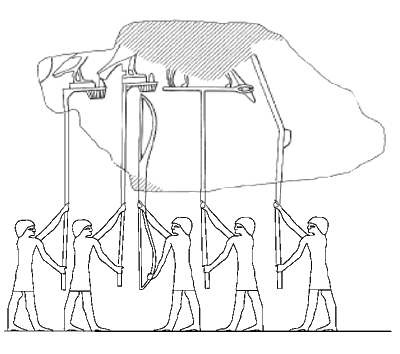
Reliefs from Abu Ghurab
(click on the images to see photos of the reliefs)
These blocks with scenes show the Sed festival
All fragments come from the so called great festival scenes, which were placed
in the corridor of the obelisk.
UC 28724 (height of the fragment: 32 cm; width: 65 cm)
Stewart 1979: 5, pl. 2.1
A procession of standards regularly follows the king. Here the standard of Wepwawet is shown, which is always flanked by warlike symbols: a bow and an angled item of archery equipment. The bearers of these three emblems proceed from the right, and meet other standard bearers coming from the left.
the reconstruction is based on, in particular: Bissing/Kees 1923: pl. 11
UC 28726 (height of the fragment: 47 cm; width: 46 cm)
On this fragment the king appears seated in a pavilion on a stepped platform.
He wears a short cloak, characteristic for the sed festival, and holds the three-pronged
'flail', a key insignium of his office. There are traces of hieroglyphs in the
pavilion with the name of the king. The hieroglyphs outside of the pavilion
might belong to a longer inscription.
Stewart 1979: 5, pl. 2.3
the reconstruction follows mainly: Bissing/Kees 1923: pl. 11
UC 28727 (height: 22 cm; width: 26 cm)
Part of a scene known in Egyptology as the 'Lion furniture procession', in which this lion-legged bed or throne is borne with other items associated with the king.
the reconstruction follows mainly: Bissing/Kees 1923: pl. 23
Stewart 1979: 5, pl. 2.7
Copyright © 2001 University College London. All rights reserved.